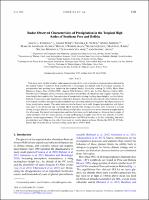Radar-Observed Characteristics of Precipitation in the Tropical High Andes of Southern Peru and Bolivia
Resumen
This study used the first detailed radar measurements of the vertical structure of precipitation obtained in the central Andes of southern Peru and Bolivia to investigate the diurnal cycle and vertical structure of precipitation and melting-layer heights in the tropical Andes. Vertically pointing 24.1-GHz Micro Rain Radars in Cusco, Peru (3350 m MSL, August 2014–February 2015), and La Paz, Bolivia (3440 m MSL, October 2015–February 2017), provided continuous 1-min profiles of reflectivity and Doppler velocity. The time–height data enabled the determination of precipitation timing, melting-layer heights, and the identification of convective and stratiform precipitation features. Rawinsonde data, hourly observations of meteorological variables, and satellite and reanalysis data provided additional insight into the characteristics of these precipitation events. The radar data revealed a diurnal cycle with frequent precipitation and higher rain rates in the afternoon and overnight. Short periods with strong convective cells occurred in several storms. Longer-duration events with stratiform precipitation structures were more common at night than in the afternoon. Backward air trajectories confirmed previous work indicating an Amazon basin origin of storm moisture. For the entire dataset, median melting-layer heights were above the altitude of nearby glacier termini approximately 17% of the time in Cusco and 30% of the time in La Paz, indicating that some precipitation was falling as rain rather than snow on nearby glacier surfaces. During the 2015–16 El Niño, almost half of storms in La Paz had melting layers above 5000 m MSL.
El ítem tiene asociados los siguientes ficheros de licencia:








